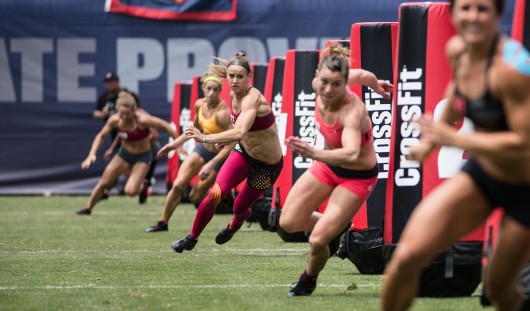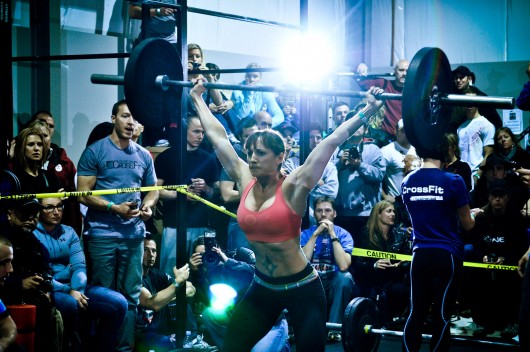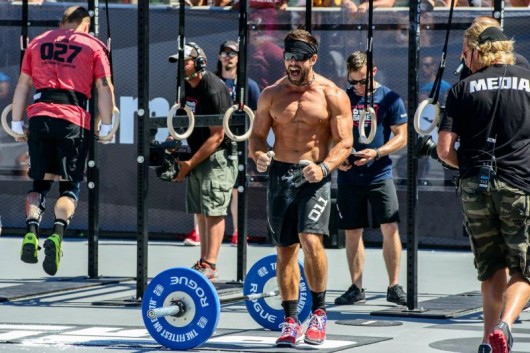The CrossFit movement is sweeping the world, but is it really the best workout plan for fitness training?
[spoiler title=”Summary: Is CrossFit Your Best Bet?” style=”fancy”] The CrossFit craze has become one of the most prominent movements in exercise this decade, but is it really the best way to train? CrossFit certainly has a lot of elements that focus on different aspects of the body, such as lifting, plyometrics, gymnastics, and running, but each day is a totally different, random workout. Without consistency and focus on specific muscle groups over a period of time, and with some of the rapid CrossFit movements, CrossFit may not be the best idea for training. Not only that, but the CrossFit exercises could even overexert and injure your muscles if not done properly[/spoiler]CrossFit is a group workout that employs a mix of exercise modalities — bodyweight training, Olympic lifting, plyometrics, flexibility, gymnastics movements, and running. CrossFit programs can mix and match any variety of exercises into a workout of the day or “WOD”.
Gyms will devise their own WODs or people can go to the official CrossFit website and perform the WOD posted there.
It’s Exercise, but It Isn’t Training
The key to understanding where CrossFit has its place in the strength and fitness industry is to recognise its pros and cons.
What exactly is CrossFit good for? Who uses it and for what purpose?
CrossFit is excellent for people looking for a hard-nosed conditioning workout. Workout culture has typically been dominated by bodybuilding and the “do 3 sets of 10” type of training. While there is nothing wrong with this, CrossFit has brought an increased awareness to the role of speed, agility and conditioning.

CrossFit workouts involve such functional exercises as:
- Pull ups
- Deadlifts
- Medicine ball throws
You won’t find trainees devoting any time to dumbbell bicep curls or chest flyes. This is a good thing for public awareness of exercise.
As we mentioned above, a CrossFit WOD could be doing a set of heavy deadlifts followed by pull ups and carrying a 20kg sandbag up a hill. Furthermore, the next day you’ll probably be doing something completely different. This ‘mixed bag’ approach to working out is exercising, not training.
The exercise versus training distinction is an important one. Training is the systematic use of exercise to achieve a specific goal. It takes good programming with the right mix of exercises, intensity, and volume.
CrossFit doesn’t take any of these variables into account so it can’t reasonably be considered training.
- If you want to get strong, then lifting heavy weights by way of compound lifts will do the trick.
- If you want to develop insane levels of muscle mass, then an intense program that works your entire body each week through sets of 6-15 reps is optimal.

Athletes in many sports require strength, power, agility and the conditioning to compete at a high level for the duration of a game. For this reason they will do a variety of different exercises. The difference is that they will do them at set times of the year, not all in the one workout. Early offseason training typically involves a lot of strength and mobility work as well as addressing injuries. An athlete’s focus shifts in the late offseason to conditioning and readying themselves for competition.
Mixing exercise modalities in one workout is great for conditioning and undoubtedly will make the average person fit. For the most part though, CrossFit is inadequate on its own for most people to produce the strength, power and muscle mass that a dedicated program could.
CrossFit Lacks in Specificity
Strength and power training require quality repetitions performed with excellent form. This isn’t possible when rushing reps and stimulating neuromuscular fatigue. Once your muscles are tired their performance drops. This is when you would stop training and rest but this doesn’t happen in a CrossFit WOD.
The same goes for plyometric jumping exercises. The explosive nature of plyometrics carries a high risk of injury and in an already fatigued state that risk increases. Again, plyometric exercises are done in short bursts with lots of rest between sets to make sure the muscles are being trained to fire quickly and without injury. After about 10 seconds of work, fatigue sets in thereby diminishing the quality of the reps.
Crossfit May Not Be Ideal for Muscle and Strength Gains
As I pointed out above, there are many factors that line up to make CrossFit workouts more injurious than other forms of exercise. Aside from that increased risk, the beginning trainee will likely experience a surge of gains, primarily because the body is adapts to exercise incredibly fast. Over time, this response tapers off and repeated training stimulus is needed for continuous gains to be made.

This progression is absolutely essential if the body is to continuing growing and responding to exercise. With CrossFit, there is no training progression built in because workouts are essentially random in nature.
The lack of movement specificity and not being able to progress movements over weeks, months, and years means gains in muscle and strength are unlikely to be optimal or continuous.
Training Under Stress is More Prone to Injury
CrossFit has been criticized by many respected trainers and coaches for not promoting a safe exercise practice. Dr. Stuart McGill, Professor of Spine Biomechanics at Waterloo University, Canada, has expressed concern that people doing WODs are practicing poor exercise form under great stress.

Like Dr. McGill, many other trainers and biomechanists have pointed out that performing high rep Olympic lifts under fatigue and with time pressure is a recipe for disaster.
Olympic lifts are traditionally done for explosiveness, not conditioning, which is the key difference. By encouraging trainees to lift heavy weights at speed without respect for the progressive fatigue of the muscles, CrossFit creates a dangerous scenario for lifters. This is especially true of novice lifters who likely have no prior experience to many of the exercises.
Group Training Often Misses Personal Attention
A good personal trainer will always start a client on easier movements in order to teach their nervous system the skill aspect of lifting, before ramping up the resistance. This does not really happen in CrossFit circles.
CrossFit WODs are designed for groups, not the specific needs of individuals.
To make matters worse, some trainers and gym owners have no clue about how to perform the specific exercises correctly. This is both an accreditation issue and a problem that stems from focusing on volume, intensity and cramming reps in to a set period of time. If quality training isn’t the primary focus, injury inevitably follows.
Overtraining is Easy
Another training variable that is more likely to be violated by the CrossFit-style shotgun approach to intense exercise is the fact that it is easy to go too far. In fact, many CrossFit advocates are proud of the fact their workouts make people keel over in pain and exhaustion. They even named a workout after Mikimba Mimms, the former Navy technician that was awarded $US300,000 for contracting the potentially fatal disease Rhabdomyolysis (“Rhabdo”) after intense CrossFit workouts. Rhabdo occurs when myoglobin from destroyed muscle tissue enters the bloodstream.

Overtraining is a serious problem almost everyone faces at some point in their exercise journey, but CrossFit seems to make overtraining a virtue. Again, the random mix of intense and heavy exercises into one program that doesn’t emphasize proper rest, individualization, and recovery is inviting trouble.
Conclusion
For many people, particularly those that aren’t used to exercise, CrossFit is probably really good for them, at least initially. But aside from this, the CrossFit experience is tainted by over-zealous advocates and workouts that make no sense.
In saying that, the emphasis on functional training and conditioning is something that the average trainee could get some benefit from. However, a properly devised metabolic resistance circuit is probably a better fit for most people as these kinds of workouts can be tailored to the individual and progressed week-after-week to achieve their fitness goals. Always be aware that training quality and appropriate rest are the fundamentals of training, and you should be skeptical of any workout philosophy that takes these qualities for granted. CrossFit is great for getting people in the gym to start getting healthier, but consistency and progress are the ways to keep them there.



